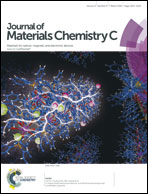Novel dithiols as capping ligands for CdSe quantum dots: optical properties and solar cell applications†
Abstract
Recently, organic ligands have been shown to play a significant role in optical and electronic properties of CdSe quantum dots and also in solar cell applications. We report organic dithiols as novel capping ligands for CdSe quantum dots (QDs). The organic dithiol compounds were designed in such a way that the two thiol groups of a dithiol (acts as a bidentate ligand) can bond directly to an inorganic CdSe QD surface which passivate effectively to show high optical efficiency by promoting interfacial charge transfer. This work would offer a direct and effective pathway to synthesize CdSe QDs that attaches dithiol ligands with aromatic functionality while maintaining the size and shape control of the CdSe QDs. The structure, crystallinity, and optical properties of the dithiol-capped CdSe QDs were analyzed by XRD, TEM, and photoluminescence. The covalent immobilization of dithiols onto CdSe QDs was confirmed by XPS, FT-IR, TGA, XRD and TEM characterizations. Further, the influence of dithiol-type capping ligands on the optical properties of highly luminescent CdSe QDs was investigated. It has been found that the growth rate and the photoluminescence intensity of CdSe QDs were strongly dependent on the type of dithiol ligands. We also experimentally investigated the use of dithiol-capped CdSe QDs in solar cells. The dithiol shell allows for the electron transport from the surface of the QDs, evidenced by better performance as CdSe QDs sensitized solar cells. The power conversion efficiency (η) of CdSe QDs reached up to 0.65%.


 Please wait while we load your content...
Please wait while we load your content...